Originally published on my Blog
The sky is darkening. Strong winds carry high-level clouds scudding across the sky as Storm Gareth skirts our city. While at ground level sharp gusts are sending compost bin lids zipping through the air like frisbees, threatening to decapitate anyone standing in their path and large rectangles of black weed-stop fabric rise gracefully from the soil. Given breath, they fill and waft like sails, before a lull rescinds their freedom and they return to earth as tired and battered heaps.
I feel very fortunate, having already secured anything that might be tempted into sudden take-off. My edge-of-the-city allotment plot is sheltered from the worst of the wind by thick old apple trees, tall woody Buddleja and a chain-link fence threaded with trained blackberries providing shelter. I am able to sit here for a while, in solitude, and it feels like I’m in the middle of the British countryside. Few will venture onto the site until after the worst of the storm has passed. They will arrive in cars to reclaim their wind-journeyed belongings, assess damage to greenhouse window panes and fallen branches, and reliably announce how “it could have been worse.”
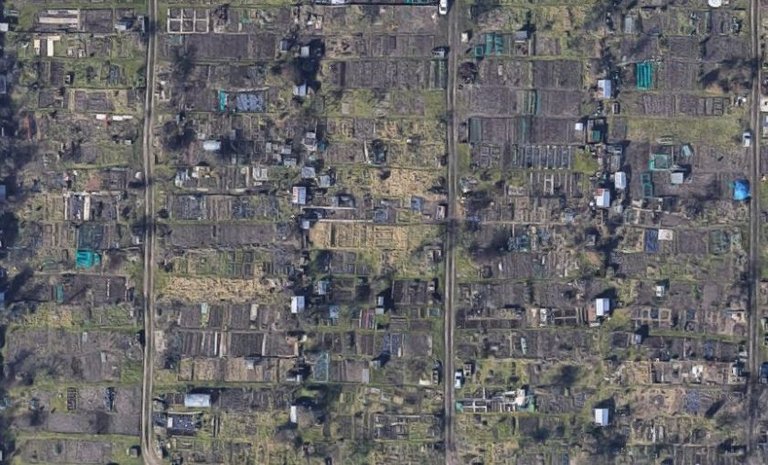
Imagery ©2019 Google, Map data ©2019 Google
My fold-up chair is comfortable only for short periods, ideal for perching between digging sessions or the general pottering that lasts entire blissful days during the summer months. Today though, I am content to simply sit and read for a short while. In my hand, the recently published Figuring (Canongate Books) by Maria Popova. I am engaged deeply in the opening story of Johannes Kepler, the difficulties he faced introducing his new theories on the planetary motion; and of Kepler’s mother, a healer and herbalist, arrested and imprisoned for many years having been accused of being a sorcerer following an argument with her neighbour, Ursula Reinbold.
I am distracted by a motion, directing my gaze away from the page and back to my surroundings—connect, disconnect, reconnect—as dry leaves whip past my head and cross paths with plumes of pale blossom that come to settle in corner drifts.
Fruit trees stand their ground, bushes hunker down, and with each gust, a fresh shower of sandy soil wafts away from the surface of bare beds. Perhaps I should have covered them but it’s too late now. Attempts to lay sheets on the ground in these winds wouldn’t look out of place in a comedy sketch.
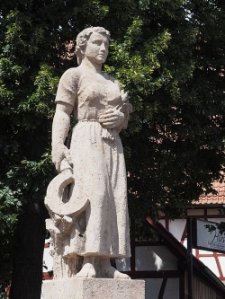
Katharina Kepler statue (image: Harke)
Returning to the book, extensive surviving trial records (preserved in the Württemberg state archives) contradict many of the stories and portrayals of Katharina Kepler, but reports that she was a herbalist do appear to be correct. Using her knowledge of plants and their powerful healing properties to produce concoctions that she would use herself and offer to people to help with their ailments, she became known as a healer.
My mind leaves Kepler’s mother for a moment as I acknowledge the arrival of the resident Robin. We first met last year when he/she—it can be difficult to tell—had barely any red feathers to its chest and we have chatted regularly since. Yes, I talk to wildlife. Don’t you?
As I watched it grow and develop, I became known as a bearer of tasty morsels and soon gained a degree of trust. During the winter I regularly stopped by to refill the feeders hanging from the apple tree, and with one eye cocked watching for predators it would perch beside me and sing. Occasionally it was startled into the undergrowth by predators unseen by me, though it would soon return when the coast was deemed clear. With all the powers of imagination and creativity at my disposal, I named it ‘Robin.’
On occasion, I have nattered to the rats too, though they have yet to natter back. I had seen one dashing alongside the compost bins, so that’s where I go to stand extremely still in the hope of spotting one. If I wait long and still enough one might slowly emerge, eyeing me suspiciously before darting into the compost bin to retrieve something edible. Out in the open they sit and watch me for a few moments, finally deciding I am not a threat to them as long as I don’t make any sudden moves or get too close. They have boundaries, you know.
My voice apparently provides no cause for alarm as I witter: ‘Hello Ratty, seen much of Mole and Badger?’ They duly ignore me until finally scurrying back from whence they came. Seeing them always feels like an honour for me, one that will never be reciprocated, and I wonder if they even remember their encounters with one of the few humans on the site that isn’t trying to kill them.
Last summer a clattering of around ten or twelve Jackdaws learned that these feeders were normally full and could just about support their weight, so they became confident regulars at the all-you-can-eat Apple Tree Buffet. I acknowledge their arrival by quietly humming ‘The Boys Are Back In Town,’ or stating “The Gang is in,” to anyone and no one. For all their apparent boldness, they require more safe distance than the rats and will soon move en masse two or three plots away at the merest hint that I’m heading in their direction, no matter how much I tiptoe and try to remain invisible behind the trellis. They miss nothing.
It is very easy to allow thoughts to drift freely in this place where inspiration and reminiscence are found in every flower, leaf, and creature.
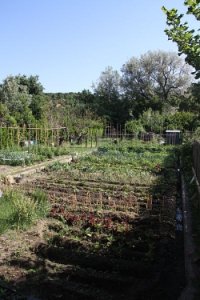
(Image: Danfoxinbox)
When I was a child my aunt Elaine had a passion for the natural world and was my environmental inspiration. She and my uncle devoted a huge allotment, and their back garden, to growing vegetables and fruit organically. Watching and listening to her passion for growing their own food sowed a seed for me back then.
It was the nineteen-seventies, ‘The Good Life’ was on TV, and as families (including my own) laughed at the haphazard efforts of Tom and Barbara Good, their lifestyle actually looked pretty good to me.
I remember how Elaine would tell anyone that would listen about pesticides, herbicides and other ‘chemical muck’ being sprayed on our food.
She would say: “If it’s in our food, it’s in us!” and “They haven’t tested it for long enough yet, they can’t KNOW what the long-term effects are, WE are the guinea pigs!” and I recall the adults in the room would try and change the subject, preferring instead to gossip about the neighbours, talk about what was on TV, or the weather. The latter was a fairly safe talking point but one that didn’t seem that interesting to me. I wanted to hear more about what happened to the food because that sounded a bit important, but they would suck the air in through their teeth and say things like: “rain, all week,” and “never get my washing dry now.” I’m still not quite sure if it was ignorance on their part, or simply that they felt too powerless to change anything so had shut down the discussion altogether.
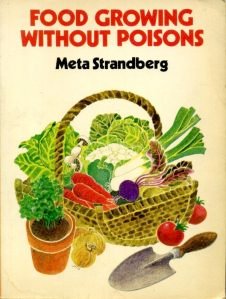
Food Growing Without Poisons, Meta Strandberg (1974)
A few years ago I found a copy of Meta Strandberg’s wonderful book, Food Growing Without Poisons (Turnstone Books) in a charity shop and refer to it often. The back cover text begins:
‘Did you know that most commercially grown vegetables are sprayed with insecticides that in many cases are dangerous to us?’
Strandberg’s 1974 book came at a time when the commercial availability of broad-spectrum glyphosate-based herbicide, Roundup, was relatively new.
Today, many more of us are worried about chemicals and poisons in the food chain, and although the book’s message didn’t achieve widespread popularity back then, the information within its pages remains just as valid today when we talk about organic food. Or as it used to be known, simply: ‘food.’
One of the things I like about being on the allotments is that there’s normally a fellow ‘allotmenteer’ nearby to natter with. As any gardener will attest, regular breaks are necessary to productivity. We’ll share our passion for growing, exchange tips, and talk about the wildlife we’ve seen—last weekend I was thrilled by visits from a Treecreeper, Yellowhammer, and a couple of Long-Tailed Tits and have been excitedly advising everyone I meet of the fact ever since.

Katy Walters / Allotments / CC BY-SA 2.0
We have a diversity of humans on the ‘plots’ too. Some, like myself, grow without the use of chemicals; a couple of my closest plot neighbours are inspired by Charles Dowding’s no-dig approach; while others favour more ‘traditional’ methods.
Among the latter are some of the most ardent Roundup fans who—I wasn’t too surprised to learn—have spent the past fifty years dousing pesticides and herbicides over pathways and the rows of vegetables they intend to eat.
What DID surprise me was that they are still doing it. Particularly in light of recent news that Glyphosate causes cancer in humans (a dramatic shift from 1 in 3 to an alarming 1 in 2 of us is now likely to develop cancer); and the harmful effects of its use on bees, fishes, molluscs and insects.
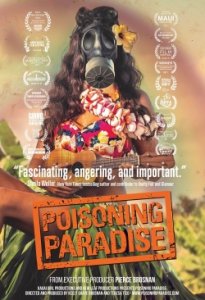
Poisoning Paradise film poster (2018) © Poisoning Paradise
Poisoning Paradise, an award-winning documentary film screened at Manchester Film Festival (UK) in March 2018 showed the plight of residents of the Hawaiian island of Kauai, the pesticide-testing grounds for GE (genetically engineered) crops where pesticides are being sprayed upwind of their neighbourhoods.
Five months later in the US, Dewayne “Lee” Johnson v. Monsanto Company became the first Roundup cancer lawsuit to proceed to trial. The court found in favour of Johnson. Then on 19th March 2019, in the Edwin Hardeman v. Monsanto Company cancer trial in Federal court, a unanimous jury decision found that Hardeman’s exposure to Roundup was a “substantial factor” in causing his non-Hodgkin lymphoma.
Monsanto and its German owner Bayer now face more than 11,200 similar lawsuits, (I follow independent journalist, Carey Gillam for the latest on this).
Following the Johnson verdict, Homebase, B&Q and Wilko announced they would be reviewing their weedkiller ranges. Then, in light of the Hardeman verdict, DIY giant Homebase reported that it would remove Glyphosate products and advised that a number of Glyphosate alternatives’ have been put on shelves. (NOTE: This piece was written in March 2019, however, as of April 15th 2021, Homebase, B&Q, and Wilko continues to sell Roundup which contains Glyphosate).
Altering the habits of a lifetime can be difficult but not impossible when there is sufficient will to enact that change. At the time of writing (28th March 2019), the London Borough of Croydon, Bristol, Derry, Trafford and Cowes just joined Hammersmith & Fulham, Lewes, Wadebridge, Glastonbury and others in their pledges to go pesticide-free. The movement is gathering pace across the UK as public concern about the use of Glyphosate and other pesticides grows. I look forward to my own local authorities: Norwich City Council and Norfolk County Council, joining them as soon as possible.
People are awakening to the reality of a poisoned food supply, damaged ecosystems and the negative health impacts coming to light (‘WE are the guinea pigs!’).
There are other chemicals that might be considered equally as damaging as Glyphosate-based herbicides, and there are, undoubtedly, other huge corporations waiting to step into the place of Monsanto/Bayer should they fall, but these are not being scrutinised in the courtroom today. Here and now, new precedents are being set and that provides a glimmer of hope that we simply didn’t have just a few months ago.
Biologist, writer and ecologist, Rachel Carson’s sensational book Silent Spring (1962) warned of the dangers to all-natural systems from the misuse of chemical pesticides such as DDT, questioned the scope and direction of modern science, and initiated the contemporary environmental movement.
“The pleasures, the values of contact with the natural world, are not reserved for the scientists. They are available to anyone who will place himself under the influence of a lonely mountain top — or the sea — or the stillness of a forest; or who will stop to think about so small a thing as the mystery of a growing seed.”
– Rachel Carson (1907 – 1964)
When we kill ants in the garden we’re removing a food source for birds and other creatures in a vast environmental network. Once we understand, as Rachel Carson did, that everything is woven together like a giant blanket of life, it is not difficult to appreciate that any such destructive actions have consequences. Causing harm to any single element of the ecosystem is to damage ourselves and other life forms within it. A person with a broken leg doesn’t say ‘oh well, it’s already broken’ and continue slamming it against a wall.
Our world is badly damaged. Fractured. There is so much still to learn about it and the life it battles to sustain. We’ve disrupted things in ways we don’t even understand, but we are not entirely ignorant. We know enough about industrial-scale damage, poisons and pollution to know that it’s horrifyingly bad. From our own individual position in the network, we each hold a responsibility to try and reverse the harm and at the very least, stop making it worse!
The allotment space is rented annually from the local authority. It doesn’t ‘belong’ only to them, any more than it does to me, but for that brief period of time, we are its custodians with a responsibility of care towards it. From my uncomfortable chair, I watch in awe as a multitude of life forms go on doing what they are supposed to do in the face of great and terrible adversity.
Turning a page, I return to Katharina Kepler. Unfortunately, she lived in an age that was not ready to comprehend new ideas about the nature of the world.
My hope is that we might know better—and will do better—now.
REFERENCES & RESOURCES:
Figuring (Canongate Books, 2019) Maria Popova
https://www.brainpickings.org/2018/11/01/figuring/
‘The Monstrous Regiment of Women, ‘Katharina Kepler Was Not a Hideous Old Witch,’ Sharon L. Jansen. (April 13th 2017)
https://www.monstrousregimentofwomen.com/2017/04/katharina-kepler-was-not-hideous-old.html
Food Growing Without Poisons (Turnstone Books, 1974) Meta Strandberg
https://biblio.co.uk/9780855000516
Charles Dowding
https://www.charlesdowding.co.uk/
US Right To Know Monsanto Roundup Trial Tracker
https://usrtk.org/monsanto-roundup-trial-tracker-index/
Investigative Journalist, Carey Gillam
1 in 2 people in the UK will get cancer (4 February 2015) Cancer Research https://www.cancerresearchuk.org/about-us/cancer-news/press-release/2015-02-04-1-in-2-people-in-the-uk-will-get-cancer
What’s the world’s most widely used herbicide doing to tiny critters? (March 18th 2019) https://www.ehn.org/whats-the-worlds-most-widely-used-herbicide-doing-to-tiny-critters-2631750527.html?rebelltitem=1#rebelltitem1
Poisoning Paradise movie (2018) Keely Shaye Brosnan and Teresa Tico
https://www.poisoningparadise.com
Manchester Film Festival
https://www.maniff.com/poisoning-paradise
DeWayne “Lee” Johnson vs Monsanto Co. Roundup Cancer Lawsuit
Edward Hardeman vs Monsanto Co. Roundup Cancer Lawsuit
https://www.baumhedlundlaw.com/edwin-hardeman-v-monsanto/
The case is only the second of more than 11,200 Roundup to go to trial https://news.yahoo.com/u-jury-determine-liability-damages-roundup-cancer-trial-194325805–finance.html
Wilko and Homebase reviewing their weedkiller ranges after US cancer patient wins £226m in damages against the manufacturer in landmark case https://www.dailymail.co.uk/news/article-6054511/Wilko-B-Q-Homebase-reviewing-weedkiller-landmark-case.html
Weedkiller is removed from DIY store shelves after US court rules in cancer link case https://www.dailymail.co.uk/news/article-6832963/Weedkiller-removed-DIY-store-shelves-court-rules-cancer-link-case.html
Pesticide-Free Towns UK
http://www.pan-uk.org/pesticide-free/
Silent Spring (Houghton Mifflin Company, 2002 ed. First published 1962) Rachel Carson
http://www.rachelcarson.org/SilentSpring.aspx
WHO International Agency for Research on Cancer (IARC)
https://www.iarc.fr/wp-content/uploads/2018/11/QA_Glyphosate.pdf
Rachel Carson
Pesticide Action Network